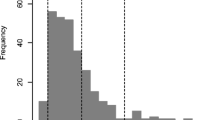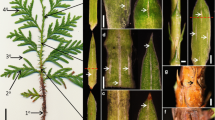Abstract
Scots pine populations contain individuals with widely differing amounts and composition of monoterpenes and exist as one of two chemotypes: with or without Δ3-carene. We investigated the significance for ecological studies of two types of variation in monoterpenes: (1) the inherent variability in the concentration of monoterpenes or their relative amounts in needles of seedlings, saplings, and mature trees; and (2) phenological variation in developing needles. The relative composition of needle monoterpenes in 5-year-old saplings changed during the needle development period until the final composition was reached upon needle maturity. Changes in composition depended on chemotype. Needles of the “no-Δ3-carene” chemotype had higher absolute concentrations of α-pinene, β-pinene, camphene, and total monoterpenes than “Δ3-carene” chemotype. For the “Δ3-carene” chemotype, the relative concentration of Δ3-carene during the needle growing season and immediately after emergence of seedlings was higher compared to that reached at needle maturity. Repeated removal of single needles (at weekly intervals during growth) from 5-year-old saplings did not influence the composition of monoterpenes. Within a natural Scots pine dominated woodland, 18% of mature Scots pines (N = 574) belonged to the “no-Δ3-carene” chemotype. Chemotypic variation within populations means that the statistical power with which differences in monoterpene concentrations can be detected is lower when sampling from the whole population compared to sampling within chemotypes. Reduction of this background variation and accounting for chiral variation if present, would significantly aid efficiency, interpretation, and understanding of processes in chemical and ecological research. One method for achieving this is the screening of plants for chemotypes before the establishment of experiments or field sampling regimes. We present a summary of suitable analytical methods for needle tissue that facilitates this prior screening.




Similar content being viewed by others
References
Barre, F., Goussard, F., and Geri, C. 2003. Variation in the suitability of Pinus sylvestris to feeding by two defoliators, Diprion pini (Hym., Diprionidae) and Graellsia isabellae galliaegloria (Lep., Attacidae). J. Appl. Entomol. 127:249–257.
Bohlmann, J., Crock, J., Jetter, R., and Croteau, R. 1998. Terpenoid-based defenses in conifers: cDNA cloning, characterization, and functional expression of wound-inducible (E)-alpha-bisabolene synthase from grand fir (Abies grandis). Proc. Nat. Acad. Sci. U. S. A. 95:6756–6761.
Chalchat, J. C., Garry, R. P., Michet, A., and Remery, A. 1985. The essential oils of 2 chemotypes of Pinus sylvestris. Phytochemistry 24:2443–2444.
Davis, E. M. and Croteau, R. 2000. Cyclization enzymes in the biosynthesis of monoterpenes, sesquiterpenes, and diterpenes. Top. Cur. Chem. 209:53–95.
Delorme, L. and Lieutier, F. 1990. Monoterpene composition of the preformed and induced resins of Scots pine, and their effect on bark beetles and associated fungi. Eur. J. For. Pathol. 20:304–316.
Duncan, A. J., Hartley, S. E., and Iason, G. R. 1994. The effect of monoterpene concentrations in Sitka Spruce (Picea sitchensis) on the browsing behavior of red deer (Cervus elaphus). Can. J. Zool. 72:1715–1720.
Forrest, G. I. 1980. Genotypic variation among native Scots pine populations in Scotland based on monoterpenes analysis. Forestry 53:101–128.
Hatcher, P. E. 1994. Seasonal and age-related variation in the needles quality of five conifer species. Oecologia 85:200–212.
Heyworth, C. J., Iason, G. R., Temperton, V., Jarvis, P. G., and Duncan, A. J. 1998. The effect of elevated CO2 concentration and nutrient supply on carbon-based plant secondary metabolites in Pinus sylvestris L. Oecologia 115:344–350.
Hiltunen, R. 1976. On variation, inheritance and chemical interrelationships of monoterpenes in Scots pine (Pinus sylvestris L.). Ann. Acad. Scient. Fenn. Series A IV Biologica 208.
Huber, D. P. W., Ralph, S., and Bohlmann, J. 2004. Genomic hardwiring and phenotypic plasticity of terpenoid-based defenses in conifers. J. Chem. Ecol. 30:2399–2418.
Iason, G. R., Duncan, A. J., Hartley, S. E., and Staines, B. W. 1996. Feeding behaviour of red deer (Cervus elaphus) on Sitka spruce (Picea sitchensis): The role of carbon-nutrient balance. For. Ecol. Manag. 88:121–129.
Iason, G. R., Lennon, J. J., Pakeman, R., Thoss, V., Beaton, J., and Sim, D. 2005. Chemical diversity within individual Scots pine trees determines biodiversity of associated ground flora. Ecol. Lett. 8:364–369.
Ikeda, T., Matsumura, F., and Benjamin, D. M. 1977. Chemical basis for feeding adaptation for pine sawflies Neodiprion rugifrons and Neodiprion swainei. Science 197:497–499.
Janson, R. 1992. Monoterpene concentrations in and above a forest of Scots pine. J. Atmos. Chem. 14:385–394.
Kainulainen, P., Holopainen, J., Palomaki, V., and Holopainen, T. 1996. Effects of nitrogen fertilization on secondary chemistry and ectomycorrhizal state of Scots pine seedlings and on growth of grey pine aphid. J. Chem. Ecol. 22:617–636.
Kainulainen, P., Utriainen, J., Holopainen, J. K., Oksanen, J., and Holopainen, T. 2000a. Influence of elevated ozone and limited nitrogen availability on conifer seedlings in an open-air fumigation system: effects on growth, nutrient content, mycorrhiza, needle ultrastructure, starch and secondary compounds. Glob. Chang. Biol. 6:345–355.
Kainulainen, P., Holopainen, J. K., and Holopainen, T. 2000b. Combined effects of ozone and nitrogen on secondary compounds, amino acids, and aphid performance in Scots pine. J. Environ. Qual. 29:334–342.
Kinloch, B. B., Westfall, R. D., and Forrest, G. I. 1986. Caledonian Scots pine—origin and genetic structure. New Phytol. 104:703–729.
Lamontagne, M., Margolis, H. A., and Bauce, É. 2000. Testing the ecophysiological basis for the control of monoterpenes concentrations along canopy profiles in thinned and unthinned balsam fir stands. Oecologia 124:318–331.
Lamontagne, M., Bauce, É., and Margolis, H. A. 2002. Testing the ecophysiological basis for the control of monoterpenes concentrations in thinned and unthinned balsam fir stands across different drainage classes. Oecologia 130:15–24.
Langenheim, J. H. 1994. Higher-plant terpenoids—a phytocentric overview of their ecological roles. J. Chem. Ecol. 20:1223–1280.
Latta, R. G., Linhart, Y. B., Lundquist, L., and Snyder, M. A. 2000. Patterns of monoterpene variation within individual trees in ponderosa pine. J. Chem. Ecol. 26:1341–1357.
Latta, R. G., Linhart, Y. B., Snyder, M. A., and Lundquist, L. 2003. Patterns of variation and correlation in the monoterpene composition of xylem oleoresin within populations of ponderosa pine. Biochem. Syst. Ecol. 31:451–465.
Lin, J. X., Sampson, D. A., and Ceulemans, R. 2001. The effect of crown position and tree age on resin-canal density in Scots pine (Pinus sylvestris L.) needles. Can. J. Bot. 79:1257–1261.
Linhart, J. B. and Thompson, J. D. 1999. Thyme is of the essence: biochemical polymorphism and multispecies deterrence. Evol. Ecol. Res. 1:151–171.
Litvak, M. E. and Monson, R. K. 1998. Patterns of induced and constitutive monoterpene production in conifer needles in relation to insect herbivory. Oecologia 114:531–540.
Martin, D., Fäldt, J., and Bohlmann, J. 2004. Functional characterization of nine Norway spruce TPS genes and evolution of gymnosperm terpene synthases of the TPS-d subfamily. Plant Physiol. 135:1908–1927.
Naydenov, K. D., Tremblay, F. M., Alexandrov, A., and Fenton, N. J. 2005. Structure of Pinus sylvestris L. populations in Bulgaria revealed by chloroplast microsatellites and terpene analysis: provenance tests. Biochem. Syst. Ecol. 33:1226–1245.
Nerg, A. M., Heijari, J., Noldt, U., Viitanen, H., Vuorinen, M., Kainulainen, P., and Holopainen, J. K. 2004. Significance of wood terpenoids in the resistance of Scots pine provenances against the old house borer, Hylotrupes bajulus, and brown-rot fungus, Coniophora puteana. J. Chem. Ecol. 30:125–141.
Paavolainen, L., Kitunen, V., and Smolander, A. 1998. Inhibition of nitrification in forest soil by monoterpenes. Plant Soil 205:147–154.
Pakeman, R. J., Beaton, J. K., Thoss, V., Lennon, J. J., Campbell, C. D., White, D., and Iason, G. R. (2006) The extended phenotype of Scots pine (Pinus sylvestris) structures the understorey assemblage. Ecography 29:451–457.
Phillips, M. A., Wildung, M. R., Williams, D. C., Hyatt, D. C., and Croteau, R. 2003. cDNA isolation, functional expression, and characterization of (+)-alpha-pinene synthase and (−)-alpha-pinene synthase from loblolly pine (Pinus taeda): stereocontrol in pinene biosynthesis. Arch. Biochem. Biophys. 411:267–276.
Pureswaran, D. S., Gries, R., and Borden, J. H. 2004a. Antennal responses of four species of tree-killing bark beetles (Coleoptera : Scolytidea) to volatiles collected from beetles, and their host and nonhost conifers. Chemoecology 14:59–66.
Pureswaran, D. S., Gries, R., and Borden, J. H. 2004b. Quantitative variation in monoterpenes in four species of conifers. Biochem. Syst. Ecol. 32:1109–1136.
Raffa, K. F. and Steffeck, R. J. 1988. Computation of response factors for quantitative analysis of monoterpenes by gas–liquid chromatography. J. Chem. Ecol. 14:1385–1390.
Rothernberg, G., Yatziv, Y., and Sasson, Y. 1998. Comparative autoxidation of 3-carene and α-pinene: factors governing regioselective hydrogen abstraction reactions. Tetrahedron 54:593–598.
Sadof, C. S. and Grant, G. G. 1997. Monoterpene composition of Pinus sylvestris varieties resistant and susceptible to Dioryctria zimmermani. J. Chem. Ecol. 23:1917–1927.
Sallas, L., Luomala, E. M., Utriainen, J., Kainulainen, P., and Holopainen, J. K. 2003. Contrasting effects of elevated carbon dioxide concentration and temperature on rubisco activity, chlorophyll fluorescence, needle ultrastructure and secondary metabolites in conifer seedlings. Tree Physiol. 23:97–108.
Schwab, W. 2003. Metabolome diversity: too few genes, too many metabolites? Phytochemistry 62:837–849.
Sjödin, K., Persson, M., Borg-Karlson, A. K., and Norin, T. 1996. Enantiomeric compositions of monoterpene hydrocarbons in different tissues of four individuals of Pinus sylvestris. Phytochemistry 41:439–445.
Sjödin, K., Persson, M., Faldt, J., Ekberg, I., and Borg-Karlson, A. K. 2000. Occurrence and correlations of monoterpene hydrocarbon enantiomers in Pinus sylvestris and Picea abies. J. Chem. Ecol. 26:1701–1720.
Theis, N. and Lerdau, M. 2003. The evolution of function in plant secondary metabolites. Int. J. Plant Sci. 164:93–102.
Thoss, V. and Byers, J. A. 2006. Monoterpene chemodiversity of ponderosa pine in relation to herbivory and bark beetle attack. Chemoecology 16:51–58.
Tiberi, R., Niccoli, A., Curini, M., Epifano, F., Marcotullio, M. C., and Rosati, O. 1999. The role of the monoterpene composition in Pinus spp. needles, in host selection by the pine processionary caterpillar, Thaumetopoea pityocampa. Phytoparasitica 27:263–272.
Vokou, D., Douvli, P., Blionis, G. J., and Halley, J. M. 2003. Effects of monoterpenoids, acting alone or in pairs, on seed germination and subsequent seedling growth. J. Chem. Ecol. 29:2281–2301.
Von Rudloff, E. 1975. Volatile leaf oil analysis in chemosystematic studies of North American conifers. Biochem. Syst. Ecol. 2:131–167.
Wallin, K. F. and Raffa, K. F. 2001. Host-mediated interactions among feeding guilds: incorporation of temporal patterns can integrate plant defense theories to predict community level processes. Ecol. 82:1387–1400.
Weidenhamer, J. D., Macias, F. A., Fischer, N. H., and Williamson, G. B. 1993. Just how insoluble are monoterpenes. J. Chem. Ecol. 19:1799–1807.
Weissmann, G. and Lange, W. 1990. A carene-free chemotype of Pinus sylvestris. Phytochemistry 29:2897–2898.
White, C. S. 1994. Monoterpenes—their effects on ecosystem nutrient cycling. J. Chem. Ecol. 20:1381–1406.
Wibe, A., Borg-Karlson, A. K., Persson, M., Norin, T., and Mustaparta, H. 1998. Enantiomeric composition of monoterpene hydrocarbons in some conifers and receptor neuron discrimination of alpha-pinene and limonene enantiomers in the pine weevil, Hylobius abietis. J. Chem. Ecol. 24:273–287.
Wink, M. 2003. Evolution of secondary metabolites from an ecological and molecular phylogenetic perspective. Phytochemistry 64:3–19.
Acknowledgements
We thank the Scottish Executive Environment and Rural Affairs Department for funding this study; Joan Beaton and Diane Smith for raising the seedlings and other assistance; David Elston of Biomathematics and Statistics Scotland for advice; and Bob Mayes, Simon Thirgood, and anonymous referees for critically reviewing the manuscript. We thank the Balmoral Estate and the National Trust for Scotland, Mar Lodge Estate for access to the study sites. JOR would like to acknowledge support by the Australian Research Council and the Joseph William Gottstein Memorial Trust fellowship, and traveling grants by the Journal of Experimental Biology and the Society of Experimental Biology.
Author information
Authors and Affiliations
Corresponding author
Rights and permissions
About this article
Cite this article
Thoss, V., O’Reilly-Wapstra, J. & Iason, G.R. Assessment and Implications of Intraspecific and Phenological Variability in Monoterpenes of Scots Pine (Pinus sylvestris) Foliage. J Chem Ecol 33, 477–491 (2007). https://doi.org/10.1007/s10886-006-9244-3
Received:
Accepted:
Published:
Issue Date:
DOI: https://doi.org/10.1007/s10886-006-9244-3




